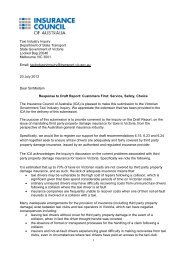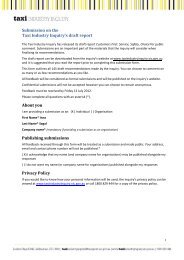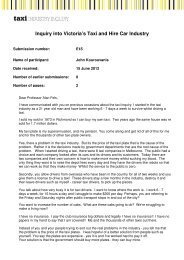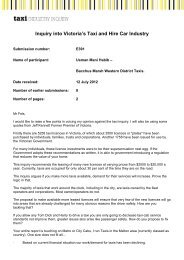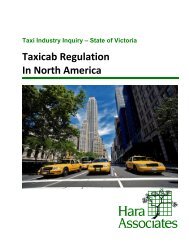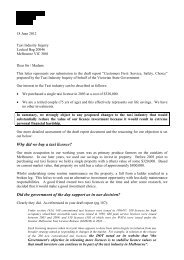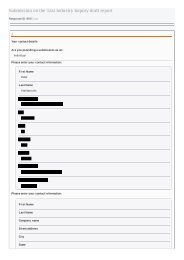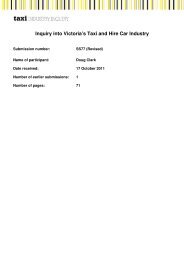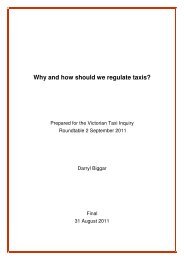Part D â Understanding and improving industry performance (PDF ...
Part D â Understanding and improving industry performance (PDF ...
Part D â Understanding and improving industry performance (PDF ...
You also want an ePaper? Increase the reach of your titles
YUMPU automatically turns print PDFs into web optimized ePapers that Google loves.
KPMG argued that these restrictions reflect the notion<br />
that hire cars serve a particular market segment <strong>and</strong><br />
should not encroach too far on markets supplied by<br />
taxis. If these restrictions are removed, there will be little<br />
difference between hire cars <strong>and</strong> taxis, apart from the fact<br />
that taxis can be hired on dem<strong>and</strong>, are subject to fare<br />
control <strong>and</strong> have a distinctive livery.<br />
It was further argued that there are some requirements<br />
on taxis that prevent them from better competing with<br />
hire cars. The requirement that taxis be hired on dem<strong>and</strong><br />
– with certain limited exceptions – was said to mean that<br />
taxi-cab operators cannot effectively differentiate their<br />
vehicles by offering a higher quality, higher fare service.<br />
Since 1999, the introduction of premium taxi services<br />
has addressed this issue to some extent. As noted in<br />
this report, for an additional fee of $11 ($10 plus GST) a<br />
better quality of vehicle can be ordered through the major<br />
Melbourne NSPs.<br />
KPMG also argued that there were no economic reasons to<br />
enforce higher st<strong>and</strong>ards of vehicles on hire cars:<br />
If taxi-cab st<strong>and</strong>ards are considered the minimum<br />
suitable to ensure the safety of passengers <strong>and</strong><br />
drivers, then we do not see any reason for higher<br />
vehicle st<strong>and</strong>ards for hire-cars to be enforced. 111<br />
The McQuillen review did not explicitly focus on the<br />
differentiation between taxis <strong>and</strong> hire cars, but supported<br />
open entry of vehicles at a ‘market price’. This approach<br />
was adopted by the Victorian Government <strong>and</strong> remains in<br />
metropolitan areas. 112<br />
Effects of the regulations on competition<br />
<strong>and</strong> <strong>performance</strong><br />
Hire cars have traditionally operated at the premium end<br />
of the commercial passenger vehicle market, providing<br />
a superior level of service at a higher price than taxis,<br />
particularly in tourism <strong>and</strong> business sectors. Operators<br />
rely on customer retention <strong>and</strong> personal repeat business,<br />
placing greater importance on the reputation of their<br />
company to attract clientele than in the taxi sector.<br />
In recent years, hire cars have increasingly competed<br />
in the pre-booked ‘ready to go’ market dominated<br />
by taxis. This has been attributed to the expansion of<br />
issued licences, stemming from the reduction in supply<br />
restrictions, <strong>and</strong> more competitive hiring charges.<br />
Dissatisfaction with taxi services has also played part.<br />
Nonetheless, there are still some significant barriers<br />
remaining to further competition: entry costs into the hire<br />
car <strong>industry</strong> are over $100,000 (for non-hybrid vehicles);<br />
it is more difficult to run fleets of vehicles; <strong>and</strong> part of the<br />
market (MPTP users) cannot be served by hire cars.<br />
It is apparent that there is potentially a much greater role<br />
for competition between taxis <strong>and</strong> hire cars. Observation<br />
of markets overseas indicates that in markets where<br />
there are fewer restrictions on licences <strong>and</strong> vehicles, hire<br />
car services have flourished.<br />
• In New York, there are entry limits on taxis but no<br />
limits on the numbers of livery vehicles. The inquiry’s<br />
underst<strong>and</strong>ing is that there are some 40,400 private<br />
hire vehicles operating in New York City (incorporating<br />
the five boroughs) – more than four times the number<br />
of yellow taxis. 113<br />
• In London, there are over 50,000 registered minicabs,<br />
against just over 23,000 ‘black cabs’ (which are also<br />
not limited in number).<br />
A further counterpoint here is Dublin: when entry into<br />
the taxi market was deregulated in 2000, there was a<br />
significant shift out of livery vehicles/hire cars (which<br />
were previously unregulated) <strong>and</strong> into taxis, meaning that<br />
the total number of vehicles per capita is similar across<br />
Dublin, London <strong>and</strong> New York. 114<br />
It is difficult to determine how much Victoria’s regulations<br />
on hire cars cost the community. It requires an<br />
assessment of how the hire car <strong>and</strong> taxi markets might<br />
respond to amendments in the current regulations, which<br />
requires a degree of conjecture. However, hire cars could<br />
be expected to play a greater role in:<br />
• Keeping taxi fares down, at least for pre-booked<br />
taxi services<br />
• Meeting peak dem<strong>and</strong> for point-to-point transport<br />
• Providing innovative services that focus on particular<br />
market niches.<br />
111 KPMG (1999), Op. Cit., p.100<br />
112 In May 2002, the Minister for Transport announced a package of taxi<br />
<strong>and</strong> hire car reforms following the National Competition Policy Review<br />
of these industries. Legislation was amended in 2002 to reduce<br />
barriers to obtaining hire car licences, whereby applicants no longer<br />
had to demonstrate the issue of a licence was ‘in the public interest’<br />
but had to pay a substantial licence fee<br />
113 In December 2011, New York announced plans to issue 18,000<br />
permits over three years that will allow livery vehicles to pick up street<br />
hails in the outer boroughs <strong>and</strong> in upper Manhattan. See case study<br />
in chapter 14 for further details on these plans<br />
114 See Goodbody (2009), Op. Cit, p.13: “Whereas in 1991 there were<br />
some 450 hackneys licensed in the Dublin area, this had increased to<br />
3,500 by the year 2000.” By 2011 the number of hackneys had fallen<br />
to 676: see www.nationaltransport.ie/downloads/taxi-reg/economicreview-spsv-<strong>industry</strong>.pdf,<br />
accessed March 2012. p. 32<br />
<strong>Underst<strong>and</strong>ing</strong> <strong>industry</strong> <strong>performance</strong> CUSTOMERS FIRST 217





